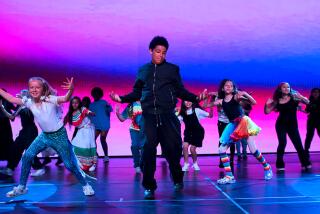Light Replaces Music in Innovative Dance Set for Performance at Sushi
SAN DIEGO — When the marriage of movement and music is complete in a dancework, it is almost possible to see the music and hear the dancing. The works of George Balanchine and other masters are often described in just those terms.
But contemporary choreographer Dana Reitz has no interest in mirroring musical phrases--or even commenting on them--in her innovative dance designs. This maverick moves in utter silence, challenging her audience to sense the sound of music inherent in the motions.
“I don’t like being pushed around too much by the music,” said Reitz by phone from New York. “I like music. I like listening to it. But hopefully, you’ll see the music--my own music--in my dances.
“I just felt that light needed to be explored (in the context of dance),” she said. “Music has been explored enough and used as a background for dance. Anyway, I’m more visual.”
By eschewing music and its intrinsic demands, Reitz has found true freedom as a dance maker.
“I can change the temperament and the timing,” she noted. “I can make radical changes as I’m working and thinking and developing. I can play with light. I’m in control.”
In her latest work, to be premiered at Sushi’s downtown loft space at 8 p.m. Friday and Saturday, Reitz will forgo sets and story line as well as music, relying only on images, gestures, and the ambient lighting designs of Clay Shirky to help her invoke the essence of “White Plains.”
“The title is really a play on words,” Reitz explained. “I named it out of fun, since Sushi is a white space. Light bounces absolutely everywhere in that kind of space. That makes it much chancier. It’s the kind of space I usually stay away from.”
This time, however, the 41-year-old iconoclast will meet the uncontrollable white box head-on, using her improvisational-based choreographic technique in tandem with samples from Shirky’s bag of light tricks.
“We’ll both have to figure out how to deal with the space,” she said. “It’s really hard when you have white walls and a low ceiling, and these details have to be ironed out. All the spaces I work in are different, but this one is really radically different. There are no guarantees about how things will work out.”
Although Reitz resists music as a source of inspiration, she has a strong musical background and uses musical lingo to discuss her dances.
“For each (dance), I start with certain ideas,” she said. “I use an improvisational structure, but the dances are really not improvised. I’m usually put into the post-modern camp, but my dances are intricate, explicit, and extremely clear--more like jazz music. I do a lot of variations on the phrasing.”
With years of ballet training under her belt, and professional stints with two celebrated bellwethers of post-modern dance (Twyla Tharp and Laura Dean) as a foundation, Reitz began developing her silence-based style of dance making 20 years ago. Since then, she has chalked up an enviable record of successes in the United States, Europe, and Australia with her “stream of consciousness moving.”
The talented dancer/choreographer
collaborated with one of the leading lighting designers in the world (Tony Award-winner Jennifer Tipton) to further her experiments with the relationship of light and movement. That piece, titled “Circumstantial Evidence,” earned her the coveted “Bessie”--the dance and performance world’s highest achievement award--for the second time in 1987. Reitz first snared the prestigious Bessie back in 1985 for “Severe Clear.”
Stillness as well as movement are concerns of Reitz’, and in “White Plains,” she uses pregnant pauses to punctuate the movement cycles. According to Reitz, “they’re all part of a whole range” of elements that form her visceral response to the steady internal rhythms of the body.
“A phrase of movement is like talking,” she said. “It’s a matter of timing. The pauses are like the ones you find in conversation.”
Reitz’s choreography emerges from drawn or painted calligraphic images, not typical dance notation. These visualizations have been lauded for their own sake, and have even been exhibited in gallery settings. With her painterly eye for light and shadow, Reitz makes dances that are understandably as visual as they are kinetic.
But it is the striking interplay of light and darkness that gives Reitz’s dances their mysterious and allusive quality. As dance critic Jack Anderson described Reitz in a New York Times review, “She was no ordinary mortal dancing. . . . She was an apparition born of darkness . . . and the shadows were always threatening to swallow her up again.”
How do aficionados take to Reitz’s brand of soundless movement?
“It depends on the audience,” she acknowledged. “If they’re told about the silence, they have a tolerance for it. It’s a kind of singing.”
More to Read
The biggest entertainment stories
Get our big stories about Hollywood, film, television, music, arts, culture and more right in your inbox as soon as they publish.
You may occasionally receive promotional content from the Los Angeles Times.










